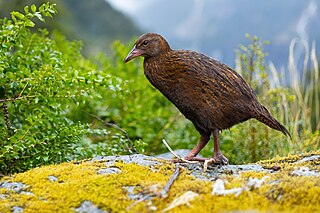
The weka, also known as the Māori hen or woodhen is a flightless bird species of the rail family. It is endemic to New Zealand. It is the only extant member of the genus Gallirallus. Four subspecies are recognized but only two (northern/southern) are supported by genetic evidence.

The Austral Islands are the southernmost group of islands in French Polynesia, an overseas country of the French Republic in the South Pacific. Geographically, they consist of two separate archipelagos, namely in the northwest the Tupua'i islands consisting of the Îles Maria, Rimatara, Rūrutu, Tupua'i Island proper and Ra'ivāvae, and in the southeast the Bass Islands composed of the main island of Rapa Iti and the small Marotiri. Inhabitants of the islands are known for their pandanus fiber weaving skills. The islands of Maria and Marotiri are not suitable for sustained habitation. Several of the islands have uninhabited islets or rocks off their coastlines. Austral Islands' population is 6,965 on almost 150 km2 (58 sq mi). The capital of the Austral Islands administrative subdivision is Tupua'i.

Charpentiera elliptica, the ellipticleaf pāpala, is an endangered species of flowering tree in the family Amaranthaceae, endemic to the island of Kauaʻi in Hawaiʻi. It inhabits coastal mesic and mixed mesic forests at elevations of 250–1,250 metres (820–4,100 ft). It is a perennial tree, growing up to 20 ft (6.1 m).

Charpentiera is a flowering plant genus in the family Amaranthaceae. It consists of five species endemic to Hawaiʻi, where they are known as pāpala, and one species found only on the island of Tubuai in the Austral Islands. All species are trees, some reaching more than 10 metres (33 ft) in height. The genus is named for Arsène Charpentier (1781-1818), professor of pharmacy at Antwerp from 1810 to 1814 and at Cherbourg from 1814 to 1816.
Austral is an endangered Polynesian language or a dialect continuum that was spoken by approximately 8,000 people in 1987 on the Austral Islands and the Society Islands of French Polynesia. The language is also referred to as Tubuai-Rurutu, Tubuai, Rurutu-Tupuai, or Tupuai. It is closely related to other Tahitic languages, most notably Tahitian and Māori.
Serianthes rurutensis is a species of flowering plant in the family Fabaceae. It is a tree endemic to the islands of Rurutu and Raivavae in the Tubuai Islands of French Polynesia.
Acalypha raivavensis is a species of plant in the family Euphorbiaceae. It is endemic to the islands of Raivavae and Tubuai in the Tubuai Islands of French Polynesia.
Glochidion raivavense, also known by its synonym Phyllanthus raivavense or by the local name mahame on the island of Tubuai, is a species of plant in the family Phyllanthaceae. It is endemic to the Austral Islands in French Polynesia, where it is native to the islands of Rurutu, Tubuai, and Raivavae.
Ixora raivavaensis is a species of flowering plant in the family Rubiaceae. It is endemic to Raivavae in the Tubuai Islands of French Polynesia, hence its name.
Macaranga raivavaeensis is a species of plant in the family Euphorbiaceae. It is endemic the islands of Raivavae and Rimatara in the Tubuai Islands of French Polynesia.
Meryta brachypoda is a species of plant in the family Araliaceae. It is native to the islands of Raivavae and Rapa Iti in the Tubuai Islands of French Polynesia, and to Henderson Island in the Pitcairn Islands.

Myoporum rapense is a plant in the figwort family, Scrophulariaceae and is endemic to French Polynesia and the Kermadec Islands. It is closely related to Myoporum laetum and there are two subspecies which are found on different island groups.
Pittosporum raivavaeense is a species of plant in the Pittosporaceae family. It is a tree endemic to the island of Raivavae, in the Tubuai Islands of French Polynesia.
Psychotria raivavaensis is a species of plant in the family Rubiaceae. It is a shrub endemic to the island of Raivavae in the Tubuai Islands of French Polynesia.
Trema discolor is a species of plant in the family Cannabaceae. It is endemic to French Polynesia. It is native to the Society Islands and to Raivavae in the Tubuai Islands.

Pelagodoxa henryana is a species of palm tree. It is native to French Polynesia, where it survives on Nuku Hiva in the Marquesas Islands. A population on Raivavae in the Tubuai Islands is presumed extinct. The species is threatened by habitat loss.

The Tubuai tropical moist forests is a tropical and subtropical moist broadleaf forests ecoregion in French Polynesia. It covers the Austral Islands.
Santalum insulare is a species of flowering plant in family Santalaceae. It is a shrub or tree native to the south-central Pacific, including the Cook Islands, Marquesas Islands, Pitcairn Islands, Society Islands, and Tubuai Islands.
Terminalia glabrata is a species of flowering plant in family Combretaceae. In the Cook Islands it is commonly known as Eastern tropical-almond, Kauariki, or ‘Enua. It is a tree native to the Cook Islands, Marquesas Islands, Samoan Islands, Society Islands, Tuamotu Archipelago, and Tubuai Islands in the South Pacific.

Cyclophyllum barbatum is a species of flowering plant in the family Rubiaceae. It is a shrub or tree native to the South Pacific, including the Caroline Islands, Cook Islands, Fiji, Marquesas Islands, Pitcairn Islands, Samoan Islands, Society Islands, Solomon Islands, Tonga, Tuamotu Archipelago, Tubuai Islands, and Vanuatu. It has been introduced to Hawaii.








